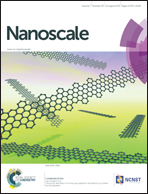Directly correlating the strain-induced electronic property change to the chirality of individual single-walled and few-walled carbon nanotubes†
Abstract
We fabricate carbon nanotube (CNT)-field effect transistors (FETs) with a changeable channel length and investigate the electron transport properties of single-walled, double-walled and triple-walled CNTs under uniaxial strain. In particular, we characterize the atomic structure of the same CNTs in the devices by transmission electron microscopy and correlate the strain-induced electronic property change to the chirality of the CNTs. Both the off-state resistance and on-state resistance are observed to change with the axial strain following an exponential function. The strain-induced band gap change obtained from the maximum resistance change in the transfer curve of the ambipolar FETs is quantitatively compared with the previous theoretical prediction and our DFTB calculation from the chirality of the CNTs. Although following the same trend, the experimentally obtained strain-induced band gap change is obviously larger (57%–170% larger) than the theoretical results for all the six CNTs, indicating that more work is needed to fully understand the strain-induced electronic property change of CNTs.


 Please wait while we load your content...
Please wait while we load your content...